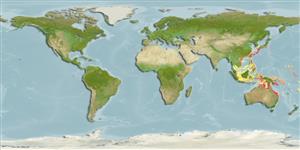Teleostei (teleosts) >
Tetraodontiformes (Puffers and filefishes) >
Monacanthidae (Filefishes)
Etymology: Paramonacanthus: Greek, para = the side of + Greek, monos = one + Greek, akantha ) thorn (Ref. 45335).
More on author: Whitley.
Environment: milieu / climate zone / depth range / distribution range
Ecology
Marine; demersal; depth range 5 - 36 m (Ref. 33065). Subtropical
Southwest Pacific: Eastern Australia.
Size / Weight / Age
Maturity: Lm ? range ? - ? cm
Max length : 11.0 cm SL male/unsexed; (Ref. 33065)
Dorsal spines (total): 2; Dorsal soft rays (total): 24 - 30; Anal spines: 0; Anal soft rays: 24 - 30; Vertebrae: 19. Body width 2.0-2.5 in head length; body depth 1.9-3.1 in SL; head length 2.8-3.3 in SL; snout length 3.6-4.9 in SL; eye diameter 2.7-4.5 in head length (Ref. 33065). Adult caudal fin with moderately long filaments on upper and middle rays (Ref. 9002). Pelvic fin rudiment movable, small; pelvic flap moderately extendable (Ref. 9002). Pale grey or yellow to brown with variable dark markings (Ref. 9002).
Found in weedy areas, usually in harbors (Ref. 9002).
Life cycle and mating behavior
Maturities | Reproduction | Spawnings | Egg(s) | Fecundities | Larvae
Kuiter, R.H., 1993. Coastal fishes of south-eastern Australia. University of Hawaii Press. Honolulu, Hawaii. 437 p. (Ref. 9002)
IUCN Red List Status (Ref. 130435)
Threat to humans
Harmless
Human uses
Tools
Special reports
Download XML
Internet sources
Estimates based on models
Preferred temperature (Ref.
123201): 24.3 - 28.4, mean 27.3 °C (based on 176 cells).
Phylogenetic diversity index (Ref.
82804): PD
50 = 0.5000 [Uniqueness, from 0.5 = low to 2.0 = high].
Bayesian length-weight: a=0.01995 (0.00943 - 0.04220), b=2.93 (2.75 - 3.11), in cm total length, based on LWR estimates for this (Sub)family-body shape (Ref.
93245).
Trophic level (Ref.
69278): 3.1 ±0.3 se; based on size and trophs of closest relatives
Resilience (Ref.
120179): High, minimum population doubling time less than 15 months (Preliminary K or Fecundity.).
Fishing Vulnerability (Ref.
59153): Low vulnerability (10 of 100).
